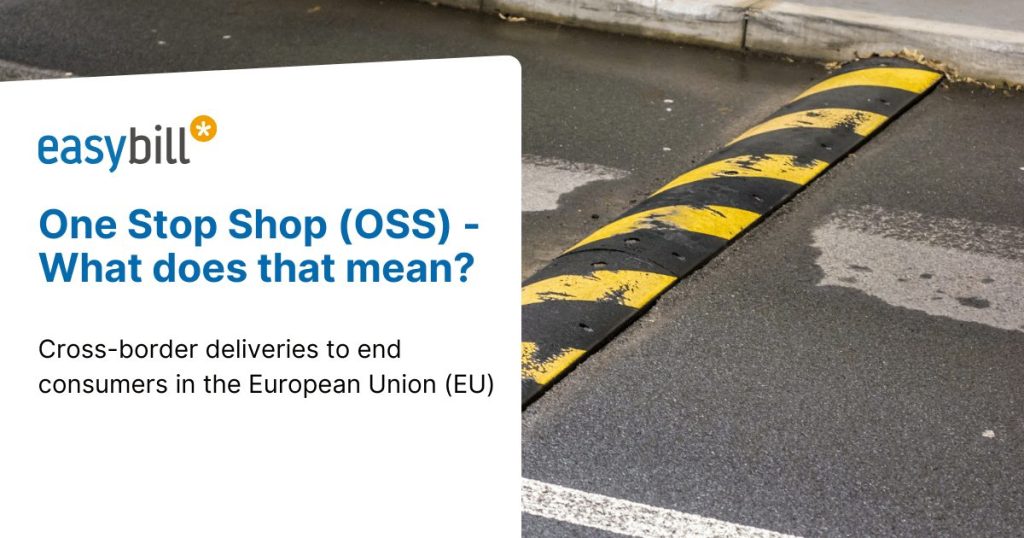
Since July 1, 2021, there has been a significant new regulation in European VAT law: the One Stop Shop (OSS). This innovation is particularly interesting for companies that make cross-border deliveries to end consumers in the European Union (EU). In this article, you will find out exactly what the One Stop Shop is, what advantages it offers, but also where its limits lie.Was genau ist der OSS?
The One Stop Shop is an electronic procedure that enables companies to declare VAT for cross-border deliveries to end consumers in other EU member states centrally via their own national tax office. This simplifies the process considerably, as companies no longer have to declare their VAT individually in each country they supply to.
Before July 1, 2021, a regulation was in place that provided for so-called “delivery thresholds”. If a company sold goods to another EU country and exceeded a certain turnover threshold in that country, it had to register for VAT there and pay the tax. These delivery thresholds were centralized with the introduction of the OSS and converted into a uniform turnover limit for the entire EU.
The new regulation of delivery thresholds since 01.07.2021
With the new regulation, the individual delivery thresholds for each EU country have been removed and replaced by an EU-wide threshold of EUR 10,000. If a company’s net turnover from cross-border sales within the EU exceeds this threshold, VAT is due in the country in which the end consumer is based.
The One Stop Shop allows companies that exceed this threshold to declare and pay the VAT due in their own country via a central platform – the OSS. This saves considerable administrative effort, as registration in several EU countries is not required.
Advantages of the One Stop Shop
The One Stop Shop offers companies several advantages:
Standardized threshold: The introduction of a uniform delivery threshold of EUR 10,000 for all EU countries ensures transparency and makes it easier to calculate when registration via the OSS becomes necessary.
Centralized VAT declaration: Companies only have to register for VAT in a single EU country, regardless of how many EU countries they supply their goods to. This significantly reduces the administrative burden.
Time saving: The complexity of dealing with VAT in different countries using different systems and procedures is eliminated. This saves companies time that they can invest in their core processes.
Simplified processes for online trade: The OSS is a big step towards efficiency, especially for small and medium-sized companies that sell online in several EU countries. It reduces the need to deal with the respective VAT regulations in the individual countries.
Limits of the One Stop Shop
Despite its numerous advantages, the One Stop Shop also has its limitations:
Prerequisite: EU-wide turnover: The OSS is only required if EU-wide turnover exceeds the threshold of 10,000 euros. For smaller companies that remain below this threshold, the old rules continue to apply, where VAT must be paid in the home country. Companies just above this threshold will have to prepare for more complex administration.
Only applies to B2C sales: The OSS can only be used for sales to end consumers (B2C). Companies that make cross-border deliveries to other companies (B2B) must continue to apply the regular VAT rules, which may still require registration in the recipient country.
Not applicable to all goods and services: Certain goods or services are excluded from the OSS procedure. Companies must check carefully whether their products fall under the OSS regulations or whether they still have to comply with separate VAT regulations in the respective countries.
Complexity with multiple sales platforms: Companies selling through multiple online platforms may struggle to aggregate all the data correctly to properly submit OSS reports. Proper data management will be crucial here.
Be aware of risks, but take advantage of great opportunities
The One Stop Shop (OSS) brings considerable simplification for online trade and cross-border deliveries to end consumers within the EU. It reduces the administrative burden and ensures that companies do not have to be registered for VAT separately in each EU country. However, using the OSS is not without its challenges, and there are clear limits to when and how it can be used.
For companies that regularly operate across borders, it is worth examining in detail whether the One Stop Shop makes sense in their situation and which processes need to be adapted in order to take full advantage of this regulation. Particular attention should be paid to the distinction between B2B transactions and specific exceptions in order to avoid unpleasant surprises.
Read also:
ZUGFeRD – the new standard for European e-invoicing
New: Receive e-invoices and enter receipts via AI
VAT in the gastronomy sector: success strategies for businesses



